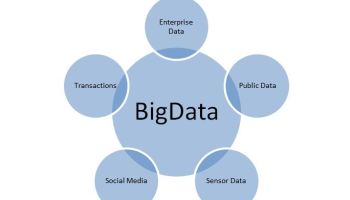What is Big Data
Data plays an enormous role in today’s world. As technology has evolved, data has grown also. Unlike traditional data, big data comes from many sources and is often unorganized. But what is big data exactly?
Big data typically refers to massive and often different sets of information. These pieces of information grow faster each second. Because it’s so big, the traditional way of storing data cannot process it. Simply put, this type of data can be defined with the three V’s: volume, velocity, and variety.

1. Volume – This refers to the amount of data. To determine the value of the data, the volume comes into play. The volume of the incoming data determines whether that piece of information is considered big data or not. It is estimated that 2.3 trillion gigabytes of data are created every day.
2. Velocity –Refers to the speed of data receiving. Because data never stops coming, it is vital to handle the upcoming information set in the near-real timeframe. Briefly, this is how fast the data is generated and processed. This is necessary so that one can meet the demands on the spot.
3. Variety – This is referring to the types of data available. Big data can come in a structured, semi-structured, and unstructured form.
There are two more components of big data. And those are:
1. Veracity
This shows the uncertainty of data. Data comes from many different sources. This makes it difficult to link data to systems, to match it, and to transform it.
If data is not organized, it can quickly get out of control. The uncertainty also is connected to how much the data presented is trustworthy. Sometimes data can be imprecise, uncertain, and unreliable.
2. Variability
Data is inconsistent. This means that much of the data comes at varying speeds and from unreliable sources.
Why is Big Data crucial to data science?
Marketing Purposes
Big data has an enormous amount of uses. For example, big data is mainly used in customer service. Many old feedback systems are replaced with data collecting systems that bring much more reliable information to companies.
For example, they can use the data to see what their customers’ needs are. They can evaluate what kind of precuts are typically purchased and the timeframe of their customers’ transactions.
Companies and organizations also use big data to improve and develop their user experience. They also use it to make future predictions and detect data patterns that point to frauds and schemes.
Machine Learning
Machine learning is a discipline in data science. Big data is also applied in machine learning. Instead of traditional programming, we now use data to them to teach them how to function. We train machines by feeding them datasets and making algorithms that enable devices in problem-solving and decision making.
This is exceptionally impressive as those same machines are able to learn from patterns, behaviors, and experiences. This is allowing them to act accordingly without any human intervention or being explicitly programmed for it.
The more data we feed into machines, the more effective they become. We get two benefits when we combine big data with machine learning. First, the set instructions and algorithms enable us to keep pace with the never-ending data influx. At the same time, the volume and the variety of that same data help the algorithms grow in size.
Here are some examples of how big data and ML complement one another:
Energy
Many companies are beginning to use technology to improve the novel level of performance. Not only that but to enhance the usage of resources and to safely and reliably produce and refine oil. They employ AI technology to discuss and predict conditions at each site. They use sensors to facilitate prognostic preservation and power, operations, and industry optimization.
Manufacturing
Many machines, such as cars, are connected with data-generating devices that collect data in many ways. For example, let’s take Volvo. Volvo takes the gathered data to predict when their product’s pat would fail. Not just that but also to indicate when the cars will need servicing. It also upholds an impressive safety record. It does that by monitoring vehicle performance during dangerous situations. This is also used to get better at driver and passenger convenience.
Social Media
Many social media platforms like Instagram and Twitter, use AI to detect and block offensive content from occurring. They automatically block posts and comments that contain cyberbullying content. As the quantity of content advances in the terrace, artificial intelligence is decisive to dispense users of the platform knowledge they might relish, battle spam, and improve the user experience.
In summary, big data is one crucial aspect of modern life. It transforms industries and the overall experiences of people. It has a positive impact. Not only that, but it also has the ability and potential to grow even bigger and better.
References:
https://tdwi.org/articles/2017/02/08/10-vs-of-big-data.aspx
https://www.sas.com/en_us/insights/big-data/what-is-big-data.html
https://www.marketingmag.com.au/hubs-c/big-data-friend-foe/
https://www.oracle.com/big-data/what-is-big-data.html
https://www.guru99.com/what-is-big-data.html
https://www.sas.com/en_us/insights/big-data/what-is-big-data.html
https://www.kdnuggets.com/2016/11/big-data-data-science-explained.html
https://blog.udacity.com/2020/08/machine-learning-for-big-data.html
https://www.forbes.com/sites/bernardmarr/2018/04/30/27-incredible-examples-of-ai-and-machine-learning-in-practice/#72d4b3487502